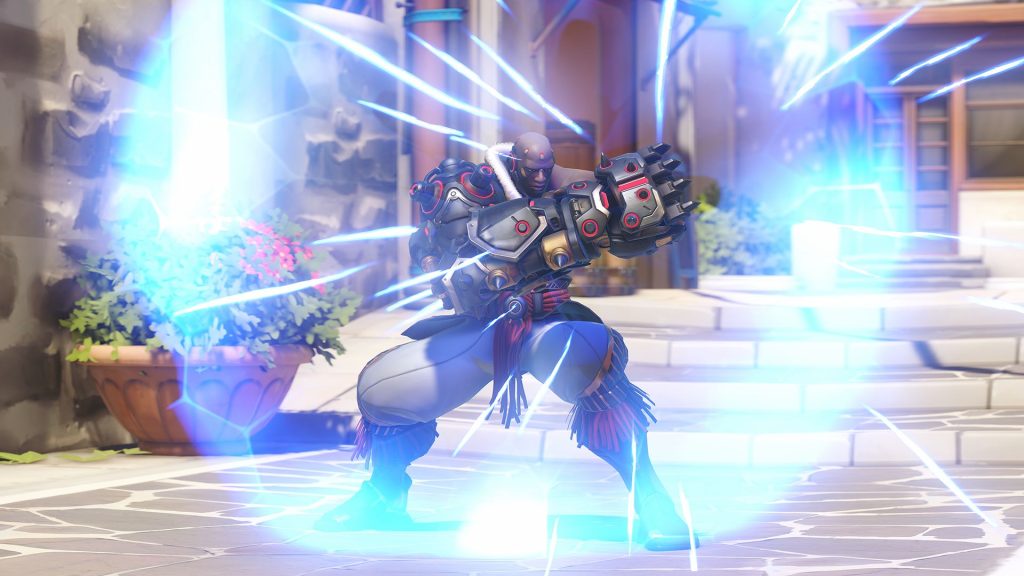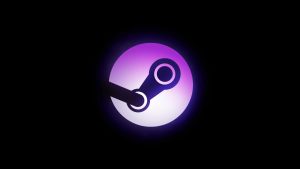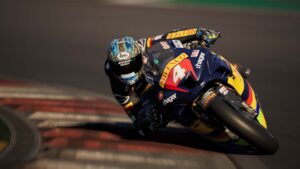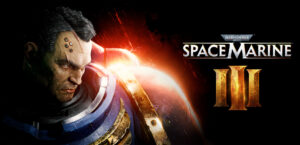Continuing with our series of hero guides for Overwatch 2 is a closer look at Baptiste, Bastion, Doomfist, and Genji. Let’s start with Baptiste, a former Talon operative and full-fledged combat medic who seeks to help those affected by war. He possesses a burst-fire rifle that doubles up as a healing grenade launcher.
More health is restored with direct hits from the healing grenades, but they’re also good for spreading healing to clumped-up allies. Like Ana, Baptiste has to reload his ammo, so be careful. His damage is also respectable, especially if you can score headshots, but it doesn’t trump Kiriko or Zenyatta.
His skills include Regenerative Burst, which heals himself and nearby allies. It was buffed to provide an instant 100 HP to the critically wounded in addition to healing over time, providing exceptional sustain in dicey situations. Amplification Matrix is his Ultimate, creating a window in front that doubles the amount of damage or healing passing through it. It applies to allies as well as Baptiste’s own healing and damage.
Exo Boots are his passive. Upon holding the Crouch button down, you can charge up the boots and press Jump to reach greater heights than normal. While providing a moderate escape tool for Baptiste, it’s way better for repositioning and attaining the high ground. Don’t use it when escaping from a decent Widow (unless you’re going around the corner). Otherwise, you’re gonna have a bad time.
Baptiste’s best tool is Immortality Field, a device with a small radius which prevents allies from dying. Though you can still damage enemies within the field, their health can’t drop below a certain threshold. It can thus negate kills from Ultimates like D.Va’s Self Destruct, Orisa’s Tera Surge, Junkrat’s R.I.P. Tire and so on. However, it can also be destroyed.
While you’ll negate the damage dealt by Soldier 76’s Tactical Visor, it will only be for a short period since it can target and destroy the field’s device. Genji’s Dragon Blade and Sojourn’s Overclock are especially dangerous since they can destroy the device before wiping the team. Nevertheless, Immortality Field is his biggest trump card, even with the hefty cooldown.
If slotted within a MOBA like League of Legends or Dota 2, Baptiste is probably best classified as an AD (Attack Damage) Support. He’s very good at sustaining his allies while pumping out some decent damage. His utility tools are also pretty good, especially since Immortality Field is like an Ultimate-on-cooldown.
Though not a meta pick these days, especially given the value that Lucio’s Sound Barrier and Speed Boost and Kiriko’s Kitsune Rush provide, a good Baptiste can be a menace and keep his team alive through thick and thin.
How to Play Bastion
Bastion ranks somewhere in the top ten of the many characters that have been as “contentious” or controversial. Even in the closed beta, he had a massive shield in Assault mode, which made him nearly impossible to kill. Throughout the years, he’s gone from under-utilized and niche to overpowered with his first rework and then back to a niche pick. Overwatch 2 reworks Bastion again, giving him a new Ultimate, mode and secondary fire.
Yes, he’s still niche, but also pretty annoying for those who don’t know how to deal with him. First up is Configuration: Recon. Bastion walks around normally, with his primary weapon being a machine gun. Though it fires slower than its Overwatch 1 version, it also deals more damage, and this can whittle down some of the squishier heroes quickly while also having a decent range.
His secondary fire is the A-36 Tactical Grenade, a bouncing explosive. It can stick to floors and enemies, causing more damage to the latter. Good for some instant burst damage, though you’ll need a fair bit of accuracy and prediction since this is a projectile.
Configuration: Assault still sees Bastion transforming and using a Gatling gun to inflict damage. However, this is now like his Tank mode from Overwatch 1. He can move around (but not jump), and the ammo count is unlimited. The downside is that on top of Assault mode having a timer, the ability to shift into it (called Reconfigure) is now on a cooldown. You now need to pick the right moment to use Assault mode.
Bastion’s Ultimate is Configuration: Artillery. It sees him transforming into a mortar launcher to fire three shells anywhere on the map. During Assault and Artillery modes, his passive Ironclad kicks in, granting 20 percent damage. It’s useful when flankers start hunting for Bastion during Artillery mode, providing some survivability since he can’t move in this mode. Heroes like Orisa, D.Va, and Sigma can destroy the shells with their abilities, while Genji can deflect them back, so beware.
Even in Overwatch 2, Bastion is a weird hero. There are better Damage dealers to choose like Sojourn, Genji and even Sombra, that provide way more utility and, well, damage. Nevertheless, he can be a proper nuisance if a team can’t really focus down his Assault mode or react quickly enough to Artillery.
If dealing with heroes like Junker Queen or Roadhog who have no shields, he can shred them quickly, though he’s also a prime target for Knife Throws and Hooks. Of course, if you’re looking to defend the Payload or Push robot on the last point, then a clutch Bastion can be useful with Assault mode.
How to Play Doomfist
Another major rework for the sequel, Doomfist didn’t just receive several changes to his kit but gone from a Damage dealer to a Tank. Uppercut is gone; Seismic Slam and Rocket Punch have been changed, and he has a new move in Power Block. Despite having less damage, he’s still a threat to teams that can’t react to his mobility.
Seismic Slam now functions a lot like Winston’s Leap. While on a flat surface, Doomfist will launch into the air and come crashing down, dealing damage in an area. While jumping, the ability will go straight down like it did in the original game.
Power Block is Doomfist’s primary tanking ability. It reduces 90 percent of damage taken from enemies in front. Upon blocking 100 damage, the damage of the next Rocket Punch is increased. Targets will also fly further with a charged Rocket Punch.
Rocket Punch deals increased damage if an enemy hits a wall and can still interrupt Ultimates like Roadhog’s Whole Hog or Cassidy’s Deadeye. You may still need to follow up with some Hand Cannon shots to kill weakened foes.
Finally, his Ultimate Meteor Strike is still much the same. Doomfist leaps into the air, and depending on where you place the targeting circle, he’ll land and deal area-of-effect damage. Enemies within that area are also slowed. Unfortunately, since it leaves him open, Meteor Strike is only really advised on stationary targets (like a Zenyatta or Ana) or when combined with Zarya’s Graviton Surge. It also makes for a good repositioning or escape tool when near death.
Doomfist’s passive ability grants shields whenever dealing damage with his abilities. Up to 150 HP of shields can be accumulated and will mitigate damage received. As for his Hand Cannon, think of it as a mini shotgun, dealing damage up close but suffering in mid to long-range. It’s good for finishing off weak enemies and poking from a distance. Be careful of the reload speed since each shot regenerates over time instead of all at once.
All in all, Doomfist is hard to recommend. He’s countered pretty easily by the likes of Orisa and Roadhog; suffers with consistent damage, unlike D.Va, Winston and even Sigma; and doesn’t have high sustain like Roadhog. A good Doomfist supported by his team can be difficult to deal with, but the amount of resources invested doesn’t quite provide the same value compared to other Tanks. Maybe Doomfist will regain some of his identity as a “feast or famine” Damage dealer in the coming months. For now, he’s a niche pick at best.
How to Play Genji
One of the more potent Damage dealers at present, and perhaps the most hated by the average Support (both as a teammate and enemy), Genji is a flanker at heart. He can wall-climb to gain a better vantage point and, unlike Kiriko and Hanzo, can double jump. It allows for some unpredictability and can help to avoid shots and leap over an enemy’s head while raining shurikens down from above.
As a projectile-based hero, Genji throws shurikens in a volley with the Primary attack button and a spread with the Secondary attack. The former is best for mid to long-range damage, while the latter works best in close to mid-range. The shurikens can also headshot, causing pretty hefty damage if you can land a volley.
Deflect allows for redirecting projectiles towards a direction. You can send bullets and projectiles back at an enemy or towards their ally. Ever wanted to kill a Mercy with shots from her teammates? Deflect makes that possible, and it’s hilarious.
It’s also good for blocking melee damage, like Reinhardt’s hammer strikes, Roadhog’s Chain Hook, Junker Queen’s Carnage, and so on (but not Doomfist’s Rocket Punch). Deflect does nothing against Winston’s Tesla Cannon, Symmetra’s Photon Beam, Zarya’s Particle Beam, Moira’s secondary fire, and so on.
The bread and butter for many Genji players is Swift Strike. It allows for dashing forward, causing damage to enemies in their path. On scoring a kill, the cooldown is reset. It’s best on weaker targets, so the strategy is to pelt them with shurikens and then Swift Strike to finish them off, or attack, use Swift Strike, and then quickly turn to finish them with shurikens. You can then use the Swift Strike reset to dash through another enemy or escape.
Dragonblade is Genji’s Ultimate and has him switching stances to deal damage with his sword. Upon activating the Ultimate, your Swift Strike is immediately reset. This allows for dashing in, activating Dragonblade, slicing up any targets, and dashing around as necessary. Each kill with Dragonblade resets Swift Strike, making it ideal for rushing to targets even if spaced apart. Dragonblade works best with Ana’s Nano Boost for extra damage and tankiness.
Overall, Genji is a pretty good Damage dealer, slotting decently into the current meta. While upcoming balance changes will nerf his shuriken amount and damage, slightly reducing his neutral game potential, he’s still very potent in burst damage. His skill floor and ceiling are high compared to Tracer or Reaper, so you’ll need some practice to fully master his kit.
For more details on Overwatch 2, check out our review here. It’s available on Xbox One, Xbox Series X/S, PS4, PS5, PC, and Nintendo Switch.















